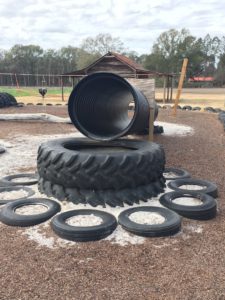

Apr 24, 2018How to build a farm market play area on budget
Georgia’s Southern Grace Farms shows how far growers can stretch dollars toward establishing a new farm market.
Jennifer McMillan of Southern Grace Farms in Enigma, Georgia, spoke at the recent Southeast Regional Fruit & Vegetable conference on the theme of “Trash to Treasure: How to Creatively Repurpose Resources into a Kid’s Wonderland.”
McMillan is the eighth generation of a farming family in Georgia’s Berrien County, a family that traces its roots in agriculture even farther back to its ancestors in Scotland. But as a college student, farming life didn’t seem attractive and she trained to become an English teacher.
“I grew up working in tobacco and I had no intention of coming back to the farm,” she said. “God had different plans for me because when I was in college the tobacco buyout happened, and in 1999 my father and uncle decided to diversify our farm by planting strawberries and the first commercial blackberries in Georgia.” The family also has continued to grow traditional South Georgia crops such as corn, cotton, wheat, peanuts and rye.
By senior year of college, she was managing a strawberry field, and by graduation, she had decided not to teach.
“I decided to come back to the farm and found a new appreciation for my heritage,” she said.
In 2015, the family decided to open a store to sell the fruit, gifts and snacks.
“I wanted to add a playground for kids, especially for field trips, but when I went to price commercial playground equipment the prices were way out of our budget,” McMillan said. “Basically, after building the store I had no budget.”


What she did have, though, was hundreds of tires from trailers at the peanut mill, raw materials, some natural resources, farm equipment, relatives willing to help, and some creativity. The tires reminded her of the play area at the small country grade school she had grown up attending. Online, she found new designs for tire pyramids, sandboxes and other play structures for children.
“I love to re-purpose old things, we use old doors, windows, and bee boxes as displays in our store, and in a way, I see it as sustainability because we are re-using something that was just trash,” McMillan said.
Tires were laid around the perimeter of the playground to form a border of the play area, and then using the trailer tires and larger tractor tires, they created two tire pyramids. Tire swings went up. A culvert pipe and tires became a slide.
The area even took on a historical twist. The family found a huge pine log in the forest, and, with an excavator, brought it to the area for a balance beam. But the log also bore the telltale scars from South Georgia’s long-gone turpentine industry – the scar patterns are known locally as catfaces because they resemble cat whiskers.
“It was also one of the largest catfaces we’d ever found and so we cut that part off for display about the turpentine industry of 100 years ago,” McMillan said.
“By the end of the project, more money had been spent than we originally planned, but it was so worth it,” she said. “We had at least a week’s worth of labor involved with six or seven guys, and then we did buy lumber for the swings, two web swings just because they were different, sand to fill in the tires on the pyramids, plastic to lay on the ground and bark for the ground covering.”
“You don’t have to jump in there and go so big the first year,” she said. “We have gradually added things as opportunity or inspiration has struck.” Some of the unlikely additions were two broken Jet Skis and hull of a boat – McMillan admits that they have nothing to do with farming, but the children love them and she has even seen adults climbing on for a picture.
Southern Grace Farms eventually realized there was a market for hosting birthday parties, and filled that need by moving a barn and an old log house that were already on the farm. This was a more complicated project than the farm had tackled so far.
“They kept the good bones from the buildings and rebuilt them at the playground so now we have two open-air cabins with seating for birthday parties or picnickers,” she said. “Luckily, we have a couple of guys on the farm who are great at carpentry projects so we pretty much turned it over to them.”
The u-pick, store, and play area have grown in popularity – McMillan says they are now “locally famous” – and the success has enabled the group to make some more expensive purchases.
“This year we recently purchased and relocated a wooden pirate ship and we are rescuing a walkway to a dock that is being taken down to make a gangplank that ends in a slide,” she said. The farm also has added a “ninja” zip line and a rolling pipe slide. It also may add a jumping pad.
The attraction has become popular enough that the group has begun to consider charging admission.
But it all started with some lumber, mulch, sand and recycled tires. McMillan urges other farm marketers to just stay creative.
“There are reusable, repurpose-able, recyclable things all around you on your farm,” she said. “I think you have to get in the zone of remembering what captured your imagination as a kid.”
– Stephen Kloosterman, VGN Assistant Editor
Above: Southern Grace Farms was able to establish a play area with simply recycled tires, sand, mulch and plastic. Photos: Jennifer McMillan














